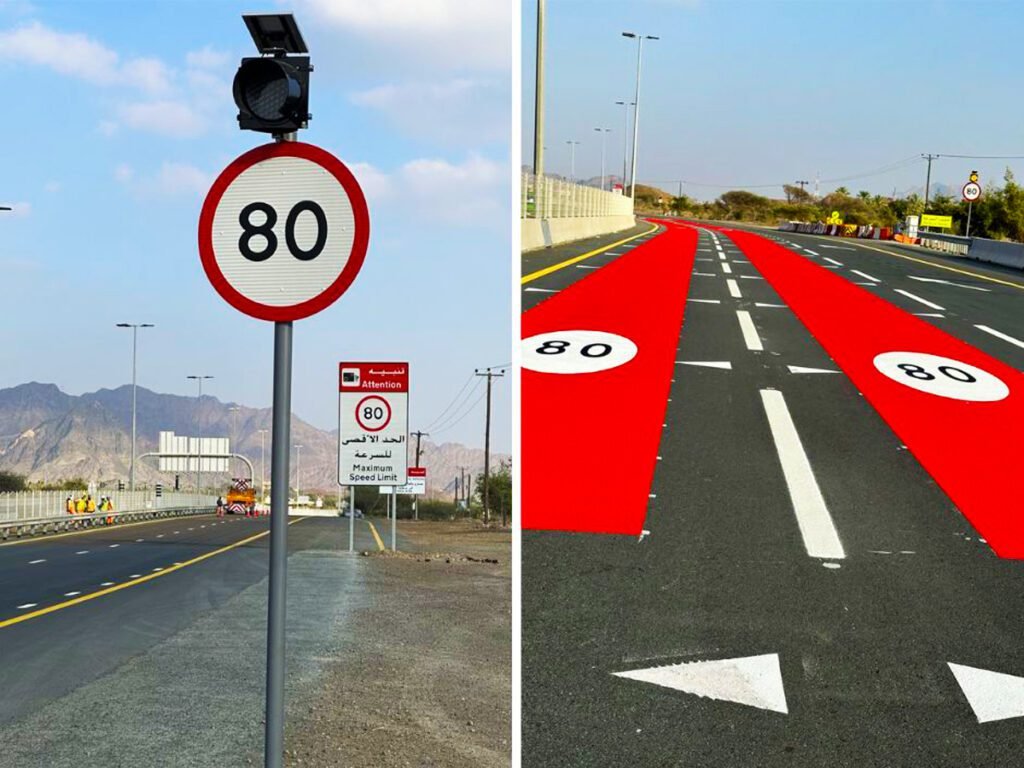Drivers in Dubai, take note – some big changes have been made to the speed limits on two of the city’s busiest roads. The Roads and Transport Authority (RTA) has officially announced new speed limits for specific stretches of Al Khail and Sheikh Zayed Roads. The goal? To improve traffic flow, reduce accidents, and make the roads safer for everyone.
If you drive these roads often, this update might affect your daily routine. The RTA says this decision comes after careful study and monitoring of traffic patterns, accident rates, and driver behaviour.
Where the Speed Limits Are Changing

According to the RTA, the changes are only for specific parts of Sheikh Zayed Road and Al Khail Road—not the entire roads. On some sections, the speed limit has been increased, while on others, it’s been reduced slightly to improve safety at busy junctions and merging points.
Sheikh Zayed Road:
One of the most important roads in Dubai, Sheikh Zayed Road connects many key parts of the city, from Dubai Marina to Downtown and beyond. It’s also known for its heavy traffic during peak hours.
The new change:
- From Dubai World Trade Centre to Interchange 2, the speed limit will be reduced from 120 km/h to 100 km/h.
- This stretch includes areas with high traffic volumes and frequent lane changes, which can lead to accidents.
Al Khail Road:

Al Khail Road is another major route that runs parallel to Sheikh Zayed Road. It’s often used by commuters looking for a quicker way to get across the city.
The update here:
- From Business Bay Crossing to Meydan Road, the speed limit will be increased from 100 km/h to 110 km/h.
- This area has been upgraded recently, with smoother road surfaces and fewer intersections, making it safer to drive at a slightly higher speed.
The RTA says these changes are designed to reflect the real driving conditions on the roads and to balance safety with travel efficiency.
Why the Speed Limits Are Changing
It’s not just about going faster or slower. The RTA has made it clear that these adjustments are based on detailed research. The changes aim to:
- Improve traffic flow: When speed limits match the natural pace of traffic, it reduces stop-and-go situations.
- Reduce accidents: Sudden braking and speeding can cause crashes, especially in high-traffic zones. Lowering speeds in critical sections helps avoid this.
- Increase road safety: With more consistent speeds, drivers are less likely to make risky lane changes or aggressive moves.
- Enhance travel times: Believe it or not, sometimes slower speeds can make your journey quicker by keeping traffic moving steadily.
What Drivers Need to Know
These speed limit changes are not suggestions—they are law. The RTA has already started installing new speed signs along the affected roads, and radar systems will be updated accordingly.
If you’re caught speeding above the new limits, the usual fines and penalties will apply. That means:
- Fines starting from AED 300 and going up depending on how far over the limit you are.
- Possible black points added to your driving license.
- Vehicle impoundment in extreme cases.
So, it’s important for all drivers to be alert, especially if you use navigation apps. While many apps update speed data quickly, it’s always safer to follow the road signs in front of you.
What the RTA Is Saying

The RTA has released a statement assuring drivers that these changes are made with their safety in mind. An official said:
“We are constantly reviewing traffic performance and safety data across Dubai’s road network. Adjusting speed limits is one of the most effective ways to respond to changing traffic patterns and road usage.”
The authority also thanked the public for their cooperation and urged drivers to stay aware and obey the new speed limits.
Public Reaction So Far
Initial responses from the public have been mixed, as expected. Some drivers welcome the changes, saying that lower speeds on Sheikh Zayed Road will reduce stress, especially in crowded areas. Others are concerned about how enforcement will be handled and whether the changes will lead to traffic slowdowns.
On Al Khail Road, the speed increase has generally been met with positive feedback. Many drivers say the road is wide and safe enough for 110 km/h, especially after recent improvements.
What Happens Next?
The new speed limits are already being implemented and will be fully enforced within the coming weeks. Road signs are being updated, and the RTA is running awareness campaigns to inform drivers.
The changes may take a few days to get used to, but the RTA believes they will have long-term benefits for everyone on the road. If successful, similar updates may happen on other roads across the city in the future.
Tips for Staying Safe on the Road
Here are a few quick reminders to help you adapt to the new speed limits:
- Watch the signs – Always look out for updated speed boards on highways.
- Use cruise control – On long drives, cruise control helps you stay within limits.
- Avoid sudden changes – Speeding up or slowing down too fast can be dangerous.
- Stay in your lane – Frequent lane changes cause accidents, especially at high speeds.
- Keep safe distances – Give enough space between you and the car in front.
Final Thoughts
Speed limit changes might seem small, but they can make a big difference when it comes to road safety and overall driving experience. Whether you’re heading to work, picking up the kids, or running errands, keeping to the limit helps keep everyone safe.
As Dubai continues to grow and traffic increases, updates like these are important steps in managing the city’s roads smartly. The next time you hit Sheikh Zayed or Al Khail Road, keep an eye out—you might need to adjust your pace. But more importantly, drive safe.
Also read: Dubai Police Launch Major Road Safety Campaign During Holidays













